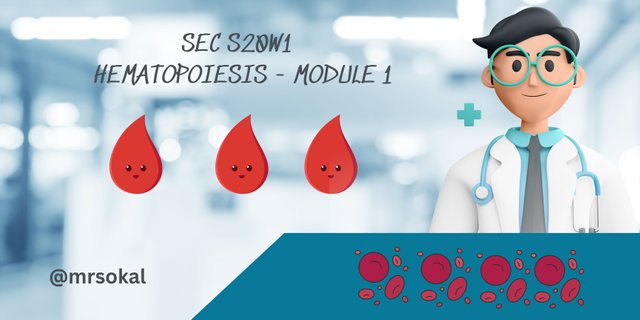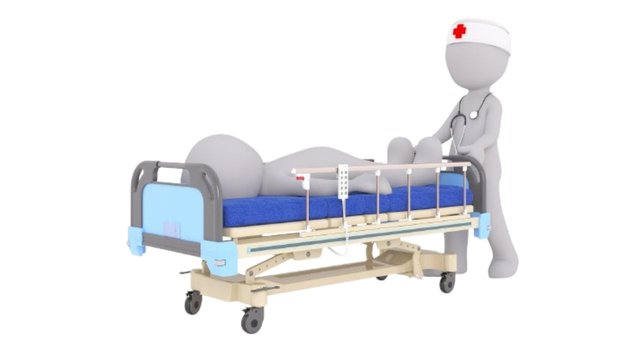Hematopoiesis is process by which blood cells can be produced and it is very essential for maintaining our body’s circulatory. It is also needed for our immune systems. In our body blood cells are generated in some specialized organs. These organs of our body is known as hematopoietic organs. They also play a vital role in immune defense, oxygen transport, and wound healing. So I want to thank @dexsyluz to organize this course in SEC season 20 which is named "Hematology [Hematopoyesis - Module 1]" and today i am participating on the first lesson.

Anatomy and function of hematopoietic organs |
|---|
Blood cells are necessary for oxygen uptake and immune defense, but also vital in blood clotting: All hematopoietic organs produce, develop and regulate the production of mature blood cells. Hematopoiesis is distributed over the main hematologic organs: bone marrow, spleen, thymus and lymph nodes which have their own characteristic contributions in blood cell formation/maturation.
.jpg)
Bone Marrow: A soft tissue substance that may be found inside the large bones of the human body and contained within bone marrow cavity between cortical shell along with endosteum. It forms all different portions of blood such as Red Blood Cells(RBCs),WhiteBlood cells(WBC's) and Platelets. Multipotent hematopoietic stem cells (HSCs), i.e., blood stem cells that we can differentiate into various types of more specialized blood cell, are primarily generated in it.
Liver: The liver is a major hematopoietic organ and during fetal development becomes the principal site of blood-cell production from approximately 2 months after conception. Despite not being a major hematopoietic organ in the adult, this function is reversible when required: if bone marrow capacity to produce blood cells falls short of demand or becomes exhausted; as occurs with certain chemo and radiotherapys. It is interesting that sick livers from animal and human models of myelofibrosis demonstrate extramedullary hematopoiesis, the same compensatory mechanism seen in other blood disorders like anemia where red cells are made by the liver when bone marrow function decreases.
Spleen: It filters blood; removing old or damaged RBCs and stores platelets. It acts as hematopoietic site in the fetal liver and under certain pathological conditions. The spleen is also responsible for breaking down and recycling out-dated red blood cells, generating white blood cells — primarily those in the lymphocyte lineage.
Thymus: This is an organ essential in the formation of T-lymphocytes, critical to adaptive immunity. The thymus is at its peak in childhood and adolescence, decreasing gradually over adulthood.
Lymph Nodes: Small, lima been shaped structures which are the hubs for immune cell activity (mainly lymphocytes) part of the lympatic system. Through the infection, they clog lymphatic fluid and thereby capture pathogens so that immune cells can mount a defense.
These organs are working together to make blood cells and help our immune system function properly. At times of stress, injury or illness their role becomes critical as the body increases demands for new blood cells.
Medullary Hematopoiesis vs Extramedullary Hematopoiesis |
|---|
The difference is as follows −
| Aspect | Medullary Hematopoiesis | Extramedullary Hematopoiesis |
|---|---|---|
| Location | Bone marrow | Spleen, liver, or other tissues |
| Normal vs. Abnormal | Normal process in healthy adults | Usually abnormal, compensatory mechanism |
| Function | Primary site for blood cell production | Secondary site for blood cell production |
| Conditions | Occurs under normal physiological conditions | Typically occurs due to bone marrow dysfunction or disease |
Make a diagram of Hematopoiesis and explain it in your own words |
|---|
.jpg)
Hematopoiesis is process in which our all the blood cells are produced from hematopoietic stem cells and it mainly affects our bones but specifically in our bone marrow. In this process a steady production is maintained of the red blood cells, white blood cells and the platelets. Heres how it works:
Hematopoietic Stem Cells (HSCs): One sort of such multipotent cells is Hematopoietic Stem Cells that are locate in the bone marrow and it is the hematopoietic stem cells that act as the precursor for all blood cells. These steem cells are firstly differentciated into two types of progenator cells :Myeloid progenitor cells and lymphoid progenitor cells.
Myeloid Progenitors →
Red Blood Cells : The major role is red blood cells that transfer oxygen from the lungs to body tissues and carbon dioxide from tissues to lungs.
Platelets : Platelet is a little and polymeric shape cell or molecule which help to blood clotting so it stop bleeding.
White Blood Cells (WBCs): These are the fighting soldier cells which have multiple characters like as neutrophil, eosinophils basophills and monocytes…Which fight from any kind of infection or other foreign body.
Lymphoid Progenitors →
B-cells: Create proteins which are capable of recognizing and binding to certain types of germs.
T-cells: Vital for committed immunity that enables the body to enter into enemy territory of infected cells or irregular cells such as cancer cells.
NK Cells: They form a group of the natural antibodies that belong to the innate immunity and are capable of killing off the viruses and cancerous cell.
Quiz Report |
|---|
Here is the report of my quiz questions:


In your opinion, what are the reasons for significant blood loss? |
|---|

This 25-year-old male patient is losing a lot of blood, most likely from many sources secondary to the car crash. The reason for this is usually the trauma itself (and I say that in a general sense) if there has been severe injury to internal organs causing bleeding then it will show, just like having a bruise adds up even more visibly beneath your skin part. The femur, or thigh bone is another significant source of blood loss-- long bones contain marrow which produces the various cellular components in our bodies that we count as a part of our total red cell mass (RCM), and fractures (especially at the scale seen here) can release large amounts both inside the bone itself, but then spill out into surrounding tissue. Moreover, internal injuries to organs like the liver or spleen could cause additional bleeding.
Who would be the ideal person to donate blood to? |
|---|
The ideal blood donor for this patient would be:
- The perfect blood donation for this patient would be; M/F, 18 < x; y > 65 years of age
- Blood group matching the patient blood ( e.g. — type O ---> needs a donor who is also type o or in urgent cases where time Is limited an universal donor of ‚o-negative would be required )
- No infection, i.e. no HIV Hepatitis or other blood born diseases
- Person that does not have a medical history of anemia or cardiovascular disease.
- Qualifies as a blood donor: normal hemoglobin & minimum 50 kg (110 lbs).
| SL No. | I would like to invite |
|---|---|
| 1 | @sduttaskitchen |
| 2 | @sampabiswas |
| 3 | @isha.ish |
আমরা সকলেই স্বাস্থ্য বিষয়ে সচেতন তবে স্বাস্থ্য সম্পর্কিত নানা তথ্যের জ্ঞান হয়ত নেই সকলের। রক্ত শরীরের জন্য একটা আবশ্যিয় উপাদান যেটা ছাড়া মানুষের বেঁচে থাকা অসম্ভব। হেমাটোপয়েটিক অঙ্গগুলো রক্ত তৈরি করতে সাহায্য করে সেটা আমার জানা ছিলো না।
আপনার সম্পূর্ণ পোস্টটি পড়ে হেমাটোপয়েটিক অঙ্গগুলোর উপকারীতা সম্পর্কে বেশ কিছু তথ্য জানতে পারলাম। শরীরের প্রতিটা অঙ্গই আমাদের জন্য গুরুত্বপূর্ণ। একটা ছাড়া অন্যটা অচল। প্রয়োজনে অন্যকে রক্ত দেওয়ার পূর্বে রক্ত দানকারী রক্ত দেওয়ার যোগ্য কিনা সেটা প্রথমে পরিক্ষা করে দেখা হয়। ভালো থাকবেন। শুভকামনা রইল আপনার জন্য।
Downvoting a post can decrease pending rewards and make it less visible. Common reasons:
Submit
Thank you so much for the report
Downvoting a post can decrease pending rewards and make it less visible. Common reasons:
Submit
amigo no colocaste la etiqueta, por favor colóquela entre las primeras 5
#hematology-s20w1
Downvoting a post can decrease pending rewards and make it less visible. Common reasons:
Submit
Dear @dexyluz, sorry for mistake, now i have place the tag correctly
Downvoting a post can decrease pending rewards and make it less visible. Common reasons:
Submit